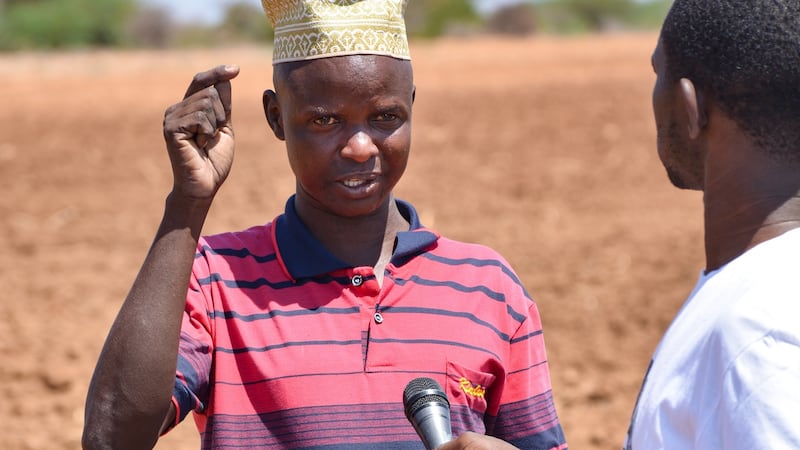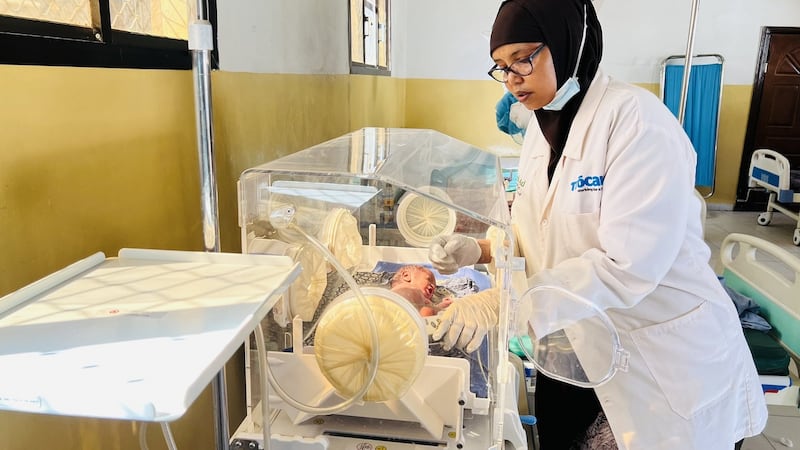In adapting to a merciless climate emergency, a large community in rural Kenya has radically changed its ways of life and food production in less than two years.
The plains of Tana River County have been a workplace for generations of East Africans, stretching back to a time when there were no nations and no borders. Pastoralism – grazing of camel, goats, and sheep across pastureland – is in the lifeline of nearly everyone who lives there. But it has become extremely problematic.
Cyclical drought is a persistent feature of the weather here, yet pastoralists have learned to adapt during recent lean times. The problem now is weather patterns have been changing rapidly and often combining to worsen impacts, as highlighted by the latest report by the UN Intergovernmental Panel on Climate Change. This comes with disastrous consequences.
In some places in Africa, there has been no appreciable rainfall for four years.
"We were pastoralists since our forefathers time," says Salah Bare Ogle, "but our livestock became totally depleted due to drought. People were facing starvation, and the few livestock we had left were stolen."

Losing the herd is the equivalent of a business going bankrupt, and there are no government safety nets. Many families had no choice but to migrate and take their chances in the slums of Nairobi. Those who stayed saw child malnutrition rates rise above emergency levels with communities heavily reliant on food aid to survive.
Then everything changed. Tana River County had a secret weapon; an untapped resource indicated in the name. “The river flows right across the whole county, so the potential is there, the land is there … and the people are there,” according to local official Mwanajuma Hiribae. “If the water can be made available to this arable land, it can dramatically change this into a food producing county.”
Yet agriculture has only ever been practised here on an ad-hoc basis; most communities have little or no experience of growing crops at scale. Salah’s home village of Matagala was a case in point. “We literally never planted anything in our lives before,” he laughs.
As it happens, Concern Worldwide Kenya had been investigating ways to tackle rising child malnutrition –beyond obvious short-term solutions of nutrition clinics and therapeutic food. "I think we came along at just the right time," says its programme director Hassan Olow.
Hassan’s team brought 20 communities together for consultations and they worked up a plan with the local government, involving irrigation, machinery, training, tools, seeds, and all the other inputs that go into clearing and preparing land for growing crops. Funding was secured from one of the world’s biggest food ingredients firms, ADM, based 10,000 km away in the American midwest.
“There was a real mixture of people involved,” Olow adds, “from small scale farmers with some experience of agriculture to people who had never sowed a single seed. We were hopeful, but we weren’t really sure what to expect.”
In their first two seasons, communities produced over 850 tonnes of combined produce, worth about €200,000. "On my farm we grow mung beans, tomatoes, maize, collard greens, spinach, cow peas, and watermelon," says Mariam Billow Samur. Elsewhere there is kale, banana, okra, onions, groundnuts, and red pepper.

Some produce is for home consumption; the rest is brought to market. The pastoralists have not entirely turned their back on their herding heritage, but moving to agriculture has been a gamechanger. "We still keep livestock, but now we have both options," Salma Juma notes.
As the recent prolonged drought has worsened across Kenya, these communities have been insulated from its worst effects. Incomes have risen, malnutrition rates have fallen, prices have stabilised, and many groups are using their profits to clear and prepare even bigger tracts of land, without any additional support from Concern. For the first time in 30 years, there was no need for emergency food distributions last year in this area.
Communal pride has driven intense competition as villages strive to be the most productive. Leading the way is Matagala, a community with hundreds of years of experience in managing livestock and no track record in agriculture.
Hope amid hunger crisis
Baby Mohamed lies in an incubator in the Dollow Referral Hospital in Dollow District, Gedo Region in southern Somalia. He was born recently at 28 weeks, weighing just 1.5 kilograms and clinging to life.
His mother gave birth to him in the Kabasa Camp for Internally Displaced Persons (IDPs) but was rushed to hospital and died of complications from her labour. The family moved from their home to the camp three months ago due to drought fuelled by climate change.
Mohamed has been monitored in an incubator in the hospital under the care of Trócaire's nursing co-ordinator Habiba Ali Maalim. Within a week of his birth his weight had increased to 1.95kgs. The incubator provides warmth, while the care team are doing feeds with formula milk using a cup and spoon every three hours.

They use the Kangaroo Mother Care Method with Mohamed, a body-to-body contact procedure performed once a day for one to two hour to help premature babies bond with parents. His father does likewise when he is able to get to the hospital from the IDP camp. He is caring for his other son, 18-months-old Hamza.
It is one success story amid a devastating hunger crisis driven by climate change taking hold in the Horn of Africa. Currently 7.7 million people in Somalia – half the population – are in dire need of humanitarian assistance given one the worst droughts in the past 40 years. Over 554,000 people have fled their homes, moving to already overcrowded IDP camps.
Trócaire Somalia country manager Paul Healy says it is devastating to witness what is happening on the ground. "Severe hunger has taken hold and it will get much worse in the coming months unless urgent action is taken."
Maternal and child health is a huge challenge, compounded by the growing hunger crisis, he adds.
Trócaire’s team of doctors and healthcare workers has been the main healthcare provider in the Gedo region for over 30 years, providing services to 19,000 people every month and educating 4,000 children. At Dollow referral health centre, they deliver an average of 110 babies a month. Typically, they are discharged within 24 hours unless they are ill or premature.
There are thousands of children like Mohamed in Somalia. “These are times of great hunger. Children are the most vulnerable. There is limited access to food, and food prices are rising, predisposing families and their children to severe malnutrition,” Healy adds.
"Climate change is wreaking havoc. Severe water shortages have heightened the risk of disease outbreaks, with people and animals now competing for untreated water from hand-dug shallow wells and dwindling rivers," he says. The climate factor is increasingly obvious.
“Cases of acute watery diarrhoea/cholera and outbreaks of measles are on the rise. There are witnessed accounts of IDP populations feeding on animal carcases at night, creating a further severe risk of disease.”









